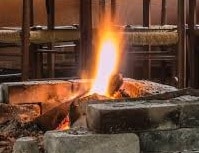The first thing we are going to do is know the etymological origin of the term forge. In this case, we can state that it is a word that derives from Latin, specifically from "fabrica", which can be translated as "craftsman's workshop" and that emanates, in turn, from the noun "faber", which is synonymous with "craftsman".
The concept is used to refer to a stove that is used for metal forging . By extension, the place where the forge is installed is known as a forge.
 The forge fire is fueled by a bellows or other similar device that allows a horizontal air current to be blown in. The stove is lit between stones or bricks that are covered with a grate: with the bellows, the current is generated that allows it to be fueled.
The forge fire is fueled by a bellows or other similar device that allows a horizontal air current to be blown in. The stove is lit between stones or bricks that are covered with a grate: with the bellows, the current is generated that allows it to be fueled.
It should be remembered that the action of forging consists of shaping a metal through impacts and compression forces. The smith or blacksmith uses the forge to heat the metal, which he holds with tongs to manipulate it. Then, with a hammer , he hits it on an anvil with the aim of forging it. Finally, once the piece has been forged, it is cooled in a container .
The forge, therefore, is essential for forging metals. It is possible to build an artisanal forge to carry out simple jobs, although in other cases the forge is larger and more complex.
A forge can consist of a space where the coal is located to light and maintain the fire, and a bellows or fan that allows air to be sent to stoke the stove. Due to its characteristics, the forge manages to preserve heat for a long time. A hole, a grate and an ashtray make it possible to collect waste and allow air to pass through.
Within the field of art, the term we are now dealing with has also been used to give titles to certain works. A good example of this is the painting titled "The Forge of Vulcano", which dates from the year 1630 and was painted by the great Sevillian baroque master of international prestige Diego Velázquez (1599 - 1660).
Among his best-known paintings is that one, which he painted while in Rome and which is currently part of the collection of the Prado Museum in Madrid.
It is an oil painting on canvas that has a size of 223 x 290 centimeters and has a marked mythological meaning. And it represents the moment in which Apollo, the god of the sun, went to the workshop of Vulcan, the blacksmith of the gods of Olympus, to tell him that his wife (Venus) is being unfaithful to him with Mars. , the god of war.
As can be seen in the painting, Vulcano receives the news, remaining stunned and pale before the attentive gaze of his companions at that moment.
